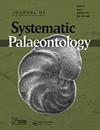A new aetiocetid (Cetacea, Mysticeti, Aetiocetidae) from the late Oligocene of Mexico
IF 2.2
2区 地球科学
Q3 EVOLUTIONARY BIOLOGY
引用次数: 2
Abstract
The aetiocetids are a well-known extinct taxon of Oligocene toothed mysticetes in the North Pacific. They display a high degree of diversity contrasting with that of other tooth-bearing mysticetes such as mammalodontids, llanocetids and Coronodon spp. The disparate developmental patterns (heterochrony) and origin of the first kelp forests in the North Pacific during the Eocene–Oligocene transition might explain such diversity. Aetiocetidae have been the focus of debate regarding the origin of baleen and filter-feeding in Mysticeti. The current interpretation of aetiocetid feeding strategies is based on the presence of teeth, unfused mandibular symphysis and lateral palatal foramina. However, our understating of their feeding apparatus function is limited, leaving associated structures like the zygomatic arch unnoticed. The present study describes a new fossil of a small-sized mysticete (∼3 m long), Kaaucetus thesaurus gen. et sp. nov., which belongs to Aetiocetidae. The protruded squamosal prominence and distinctive zygomatic process present in this new fossil highlight disparity in feeding morphology amongst aetiocetids. Moreover, the zygomatic arch complex and masticatory muscle system reconstruction are crucial to interpreting the likely capability of mastication (shearing motion) in aetiocetids and other toothed mysticetes. Lastly, the record of several aetiocetid genera in Mexico extends the geographical range of the group into the subtropical region. https://zoobank.org/urn:lsid:zoobank.org:pub:urn:lsid:zoobank.org:pub:26167623-8F9C-4C03-8CA2-911D93519031墨西哥晚渐新世一新种(鲸目,鲸目,鲸科)
亚目是北太平洋渐新世齿神秘科中一个著名的已灭绝分类单元。它们表现出高度的多样性,与其他长有牙齿的神秘动物形成鲜明对比,如长毛象、轮尾类和冠齿类。始新世-渐新世过渡期间,北太平洋第一批海带林的不同发育模式(异时性)和起源可能解释了这种多样性。关于Mysticeti的须鲸起源和滤食性,Aetiocetidae一直是争论的焦点。目前对病因喂养策略的解释是基于牙齿、未融合的下颌联合和腭侧孔的存在。然而,我们对其进食器功能的了解是有限的,没有注意到颧骨弓等相关结构。本研究描述了一个小型神秘学家(约3米长)的新化石,Kaaucetus同义词库gen.et sp.nov.,属于Aetiocetidae。这一新化石中突出的鳞片突起和独特的颧骨突突出了毛类动物在进食形态上的差异。此外,颧骨弓复合体和咀嚼肌系统重建对于解释以太菌和其他牙齿神秘体可能的咀嚼能力(剪切运动)至关重要。最后,墨西哥的几个aetiocetid属的记录将该类群的地理范围扩展到了亚热带地区。https://zoobank.org/urn:lsid:zoobank.org:pub:urn:lsid:zoobank.org:pub:26167623-8F9C-4C03-8CA2-911D93519031
本文章由计算机程序翻译,如有差异,请以英文原文为准。
求助全文
约1分钟内获得全文
求助全文
来源期刊
CiteScore
5.30
自引率
7.70%
发文量
31
审稿时长
>12 weeks
期刊介绍:
The Journal of Systematic Palaeontology publishes papers that provide novel and impactful results in phylogenetics and systematics and that use these results in ways that significantly advance rigorous analyses of palaeogeography, palaeobiology, functional morphology, palaeoecology or biostratigraphy. Papers dealing with theoretical issues or molecular phylogenetics are also considered if they are of relevance to palaeo-systematists. Contributions that include substantial anatomical descriptions, descriptions of new taxa or taxonomic revisions are welcome, but must also include a substantial systematics component, such as a new phylogeny or a revised higher-level classification. Papers dealing primarily with alpha-taxonomic descriptions, the presentation of new faunal/floristic records or minor revisions to species- or genus-level classifications do not fall within the remit of the journal.

 求助内容:
求助内容: 应助结果提醒方式:
应助结果提醒方式:


